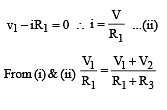Test: MCQs (One or More Correct Option): Current Electricity | JEE Advanced - JEE MCQ
11 Questions MCQ Test 35 Years Chapter wise Previous Year Solved Papers for JEE - Test: MCQs (One or More Correct Option): Current Electricity | JEE Advanced
Capacitor C1 of capacitance 1 micro-farad and capacitor C2 of capacitance 2 microfarad are separately charged fully by a common battery. The two capacitors are then separately allowed to discharge through equal resistors at time t = 0.
Read the following statements carefully:
Y : The r esisti vity of a semicon ductor decreases with increase of temperature.
Z : In a conducing solid, the rate of collisions between free electrons and ions increases with increase of temperature Select the correct statement(s) from the following;
| 1 Crore+ students have signed up on EduRev. Have you? Download the App |
In the circuit shown in Figure the current through


When a potential difference is applied across, the current passing through
For the circuit shown in the figure

For the resistance network shown in the figure, choose the correct option(s)

Heater of an electric kettle is made of a wire of length L and diameter d. It takes 4 minutes to raise the temperature of 0.5 kg water by 40 K. This heater is replaced by a new heater having two wires of the same material, each of length L and diameter 2d. The way these wires are connected is given in the options. How much time in minutes will it take to raise the temperature of the same amount of water by 40 K?
Two ideal batteries of emf V1 and V2 and three resistances R1, R2 and R3 are connected as shown in the figure. The current in resistance R2 would be zero if

In an aluminium (Al) bar of square cross section, a square hole is drilled and is filled with iron (Fe) as shown in the figure. The electrical resistivities of Al and Fe are 2.7 × 10–8 Ω m and 1.0 × 10–7 Ω m, respectively. The electrical resistance between the two faces P and Q of the composite bar is

An incandescent bulb has a thin filament of tungsten that is heated to high temperature by passing an electric current. The hot filament emits black–body radiation. The filament is observed to break up at random locations after a sufficiently long time of operation due to non–uniform evaporation of tungsten from the filament. If the bulb is powered at constant voltage, which of the following statement(s) is(are) true?
In the circuit shown below, the key is pressed at time t = 0. Which of the following statement(s) is(are) true?

|
347 docs|185 tests
|
|
347 docs|185 tests
|





























 it emits light of lower wavelength or higher band of frequencies.
it emits light of lower wavelength or higher band of frequencies.


















